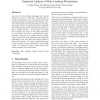Free Online Productivity Tools
i2Speak
i2Symbol
i2OCR
iTex2Img
iWeb2Print
iWeb2Shot
i2Type
iPdf2Split
iPdf2Merge
i2Bopomofo
i2Arabic
i2Style
i2Image
i2PDF
iLatex2Rtf
Sci2ools
RAID
2005
Springer
2005
Springer
Empirical Analysis of Rate Limiting Mechanisms
One class of worm defense techniques that received attention of late is to “rate limit” outbound traffic to contain fast spreading worms. Several proposals of rate limiting techniques have appeared in the literature, each with a different take on the impetus behind rate limiting. This paper presents an empirical analysis on different rate limiting schemes using real traffic and attack traces from a sizable network. In the analysis we isolate and investigate the impact of the critical parameters for each scheme and seek to understand how these parameters might be set in realistic network settings. Analysis shows that using DNS-based rate limiting has substantially lower error rates than schemes based on other traffic statistics. The analysis additionally brings to light a number of issues with respect to rate limiting at large. We explore the impact of these issues in the context of general worm containment.
| Added | 28 Jun 2010 |
| Updated | 28 Jun 2010 |
| Type | Conference |
| Year | 2005 |
| Where | RAID |
| Authors | Cynthia Wong, Stan Bielski, Ahren Studer, Chenxi Wang |
Comments (0)

